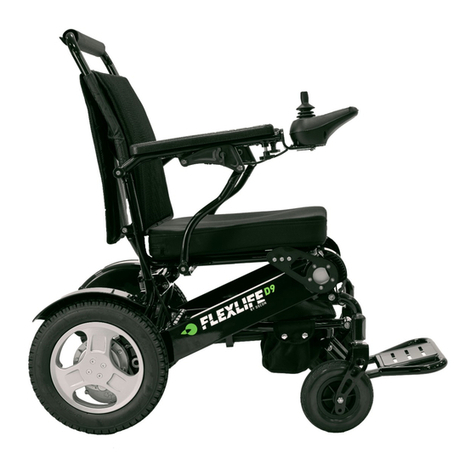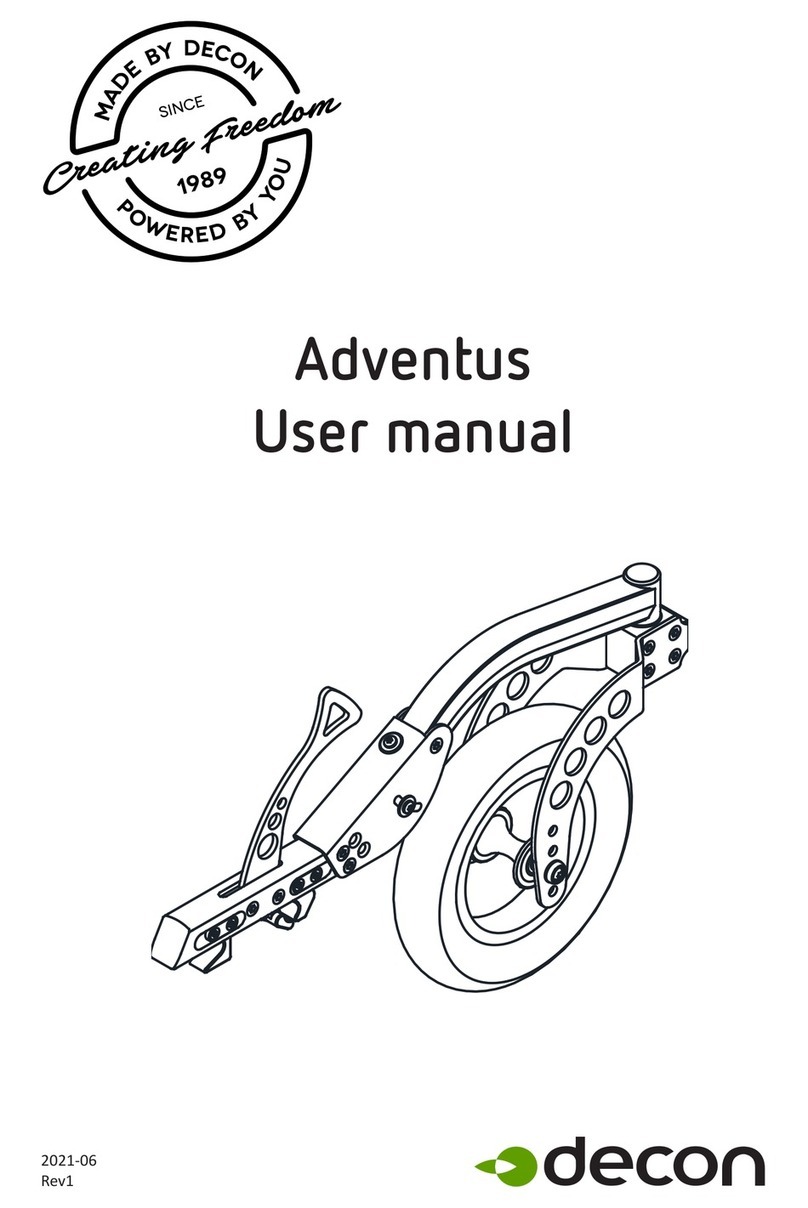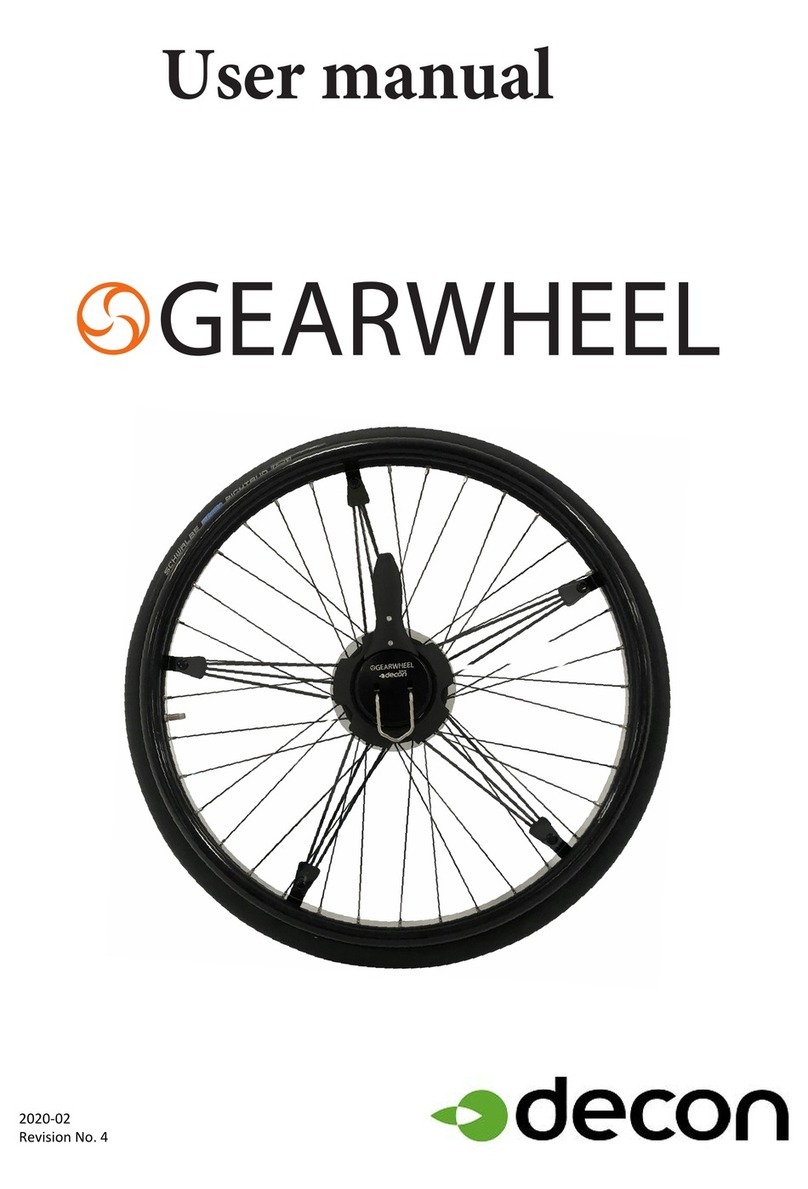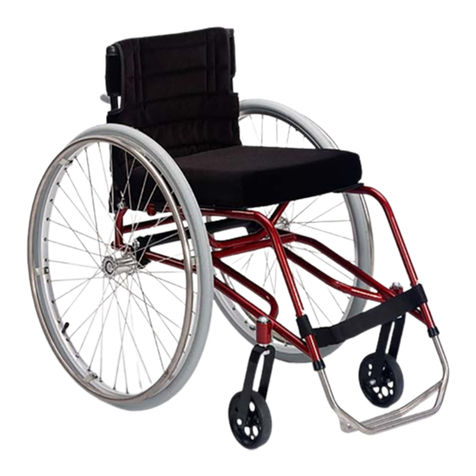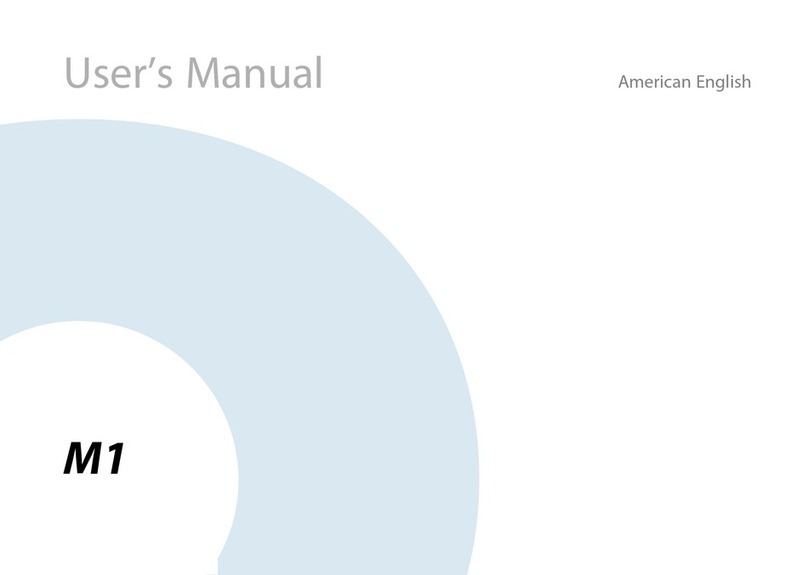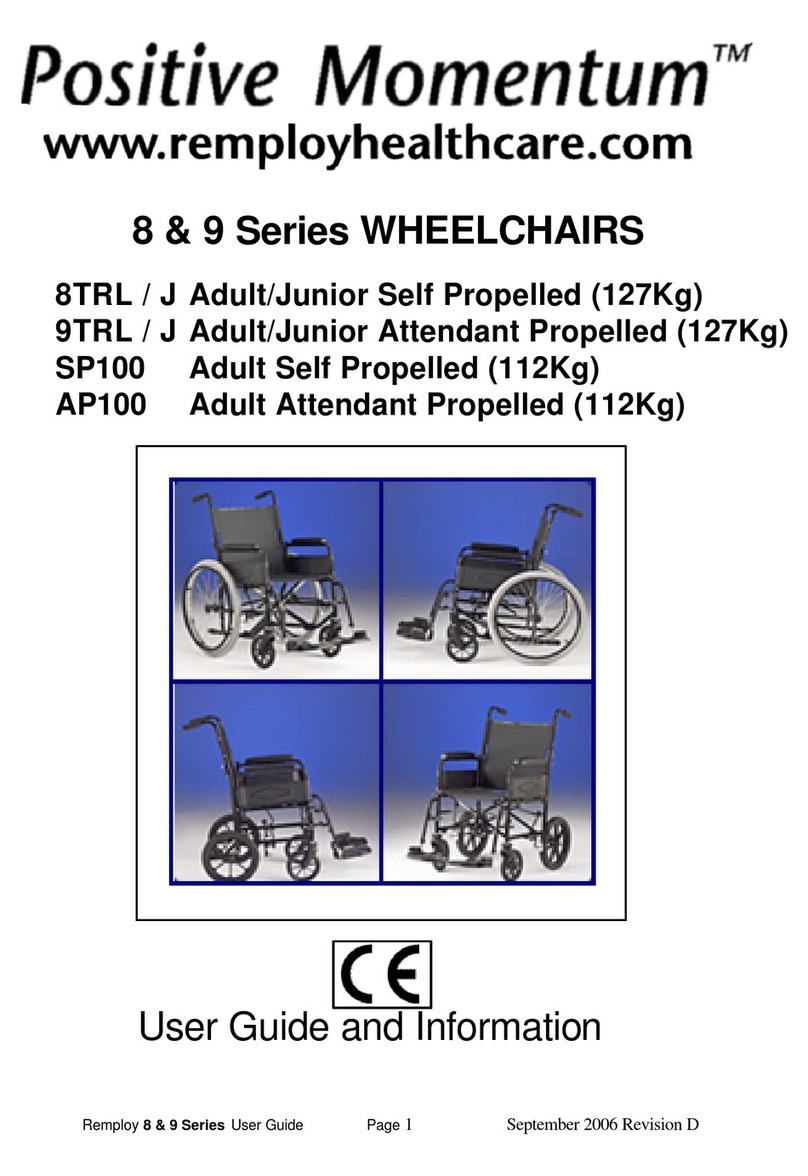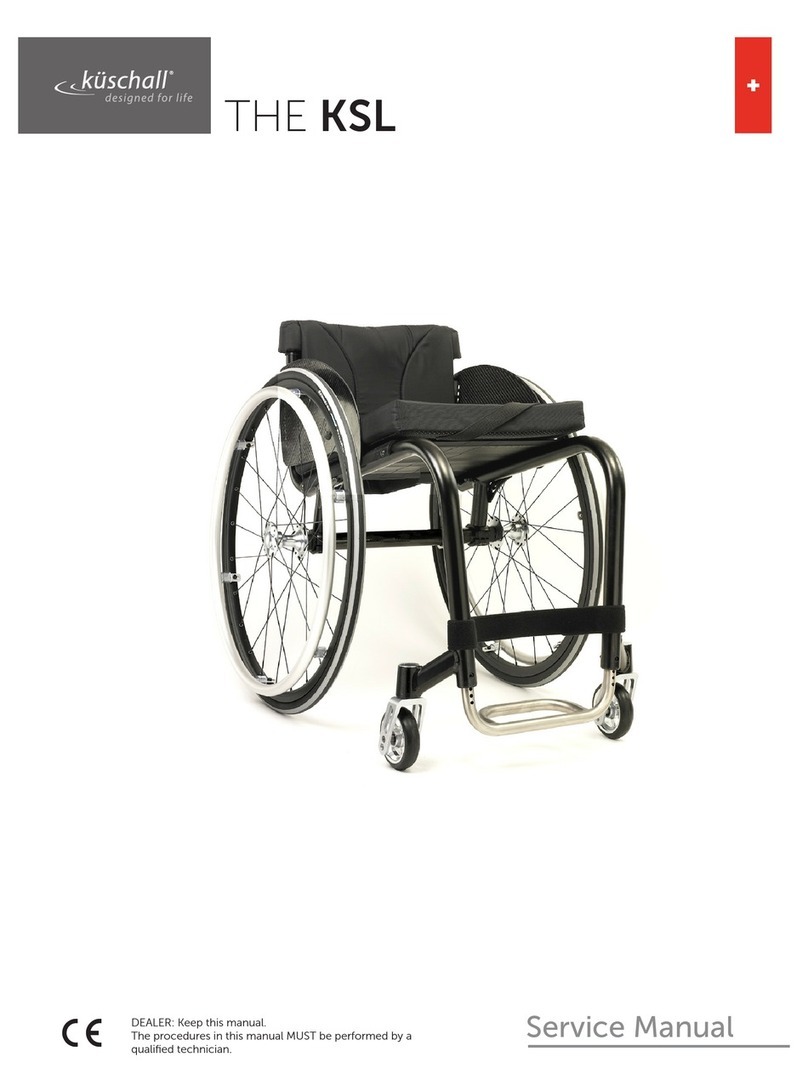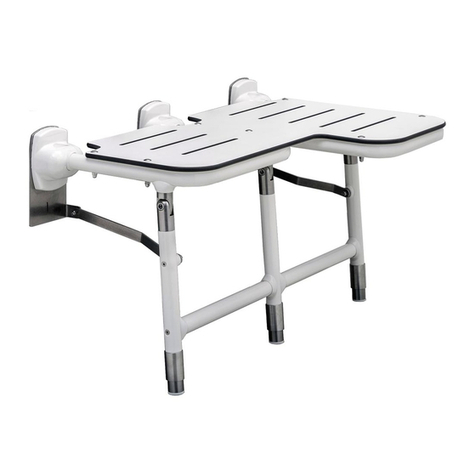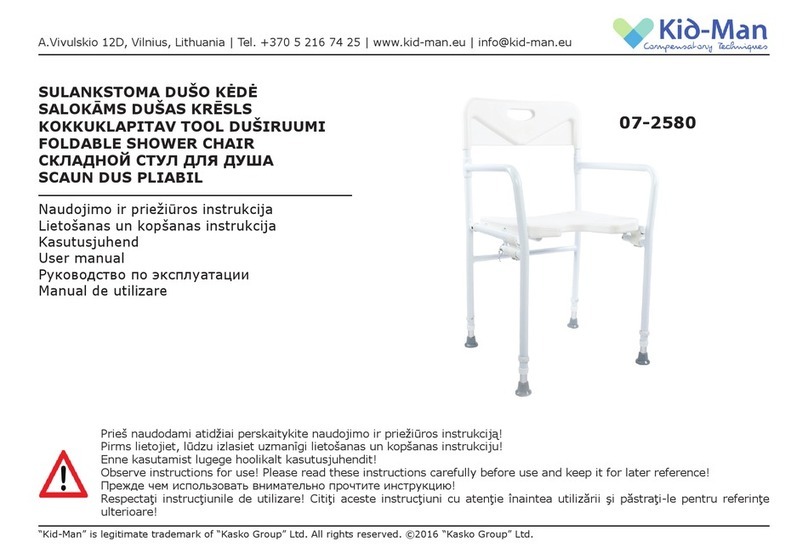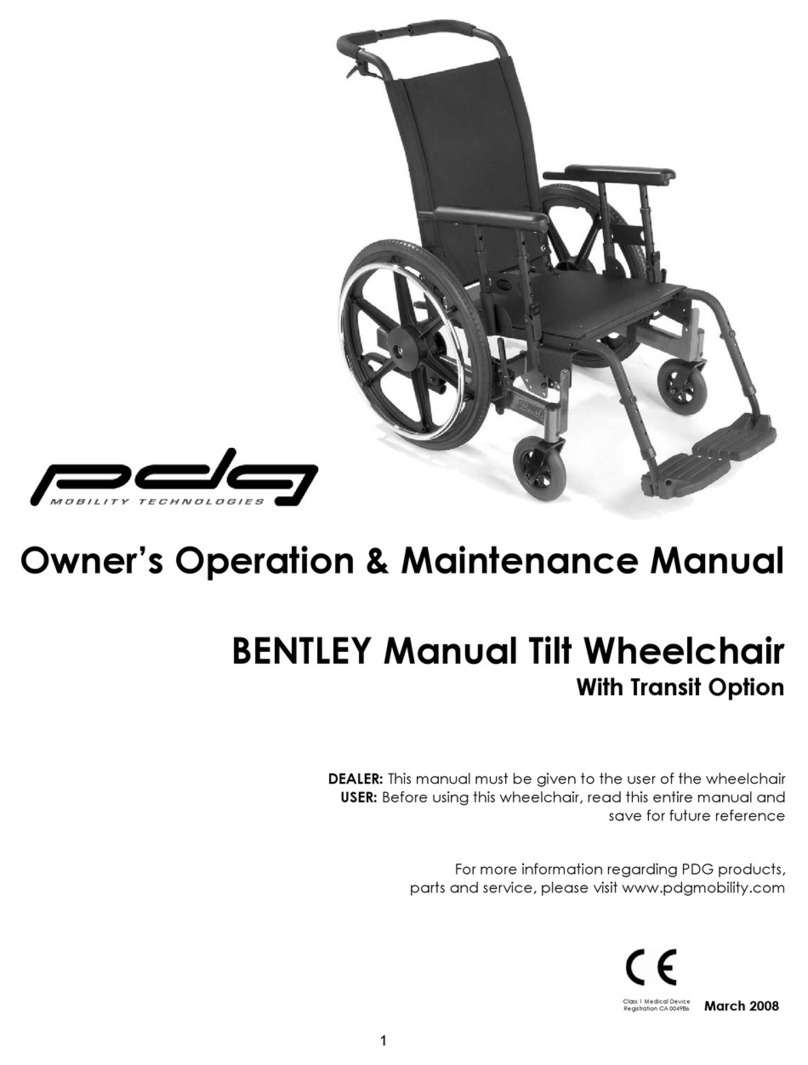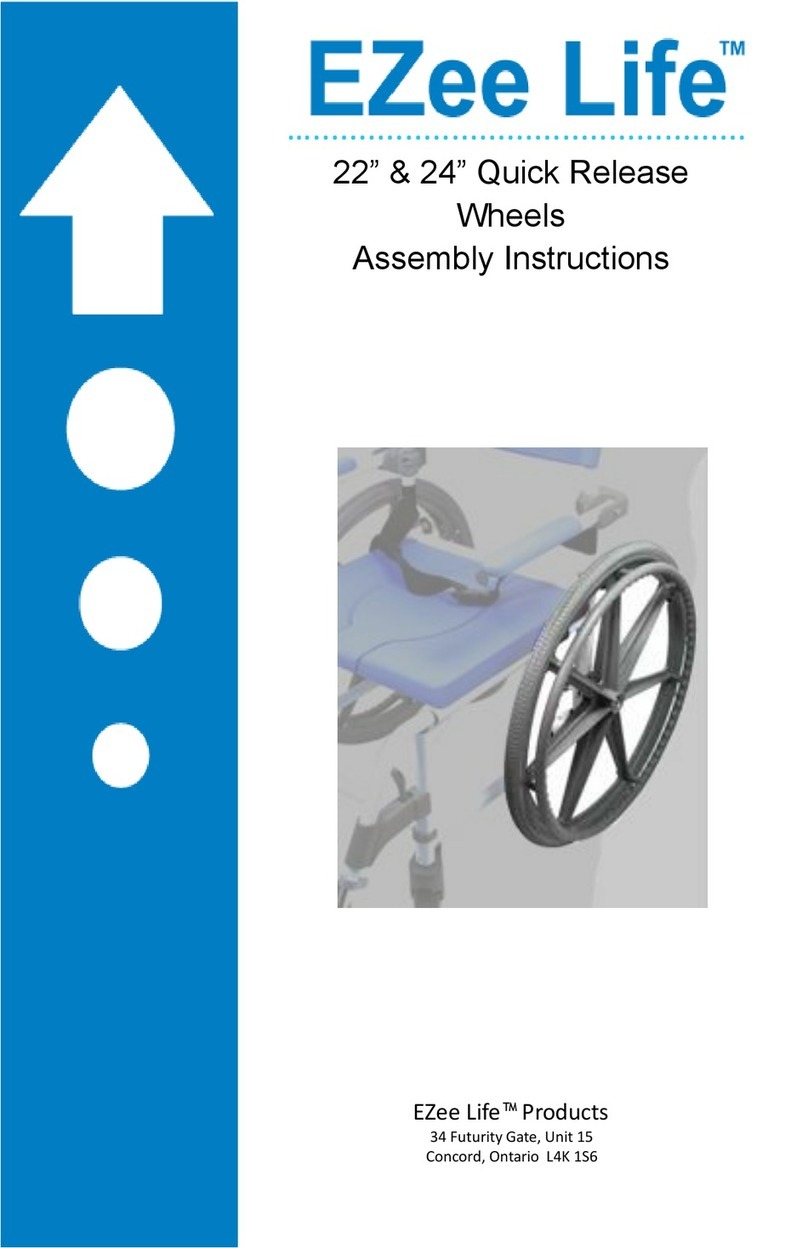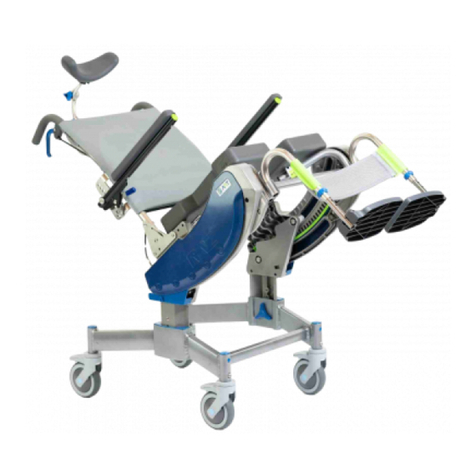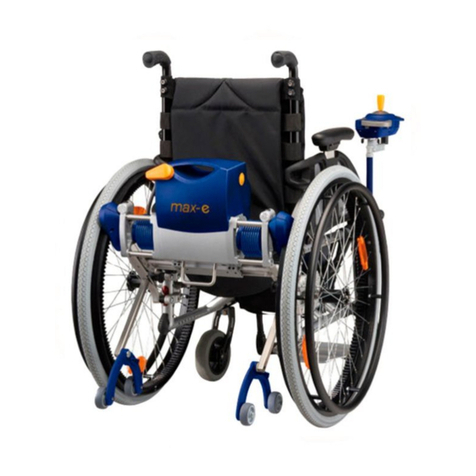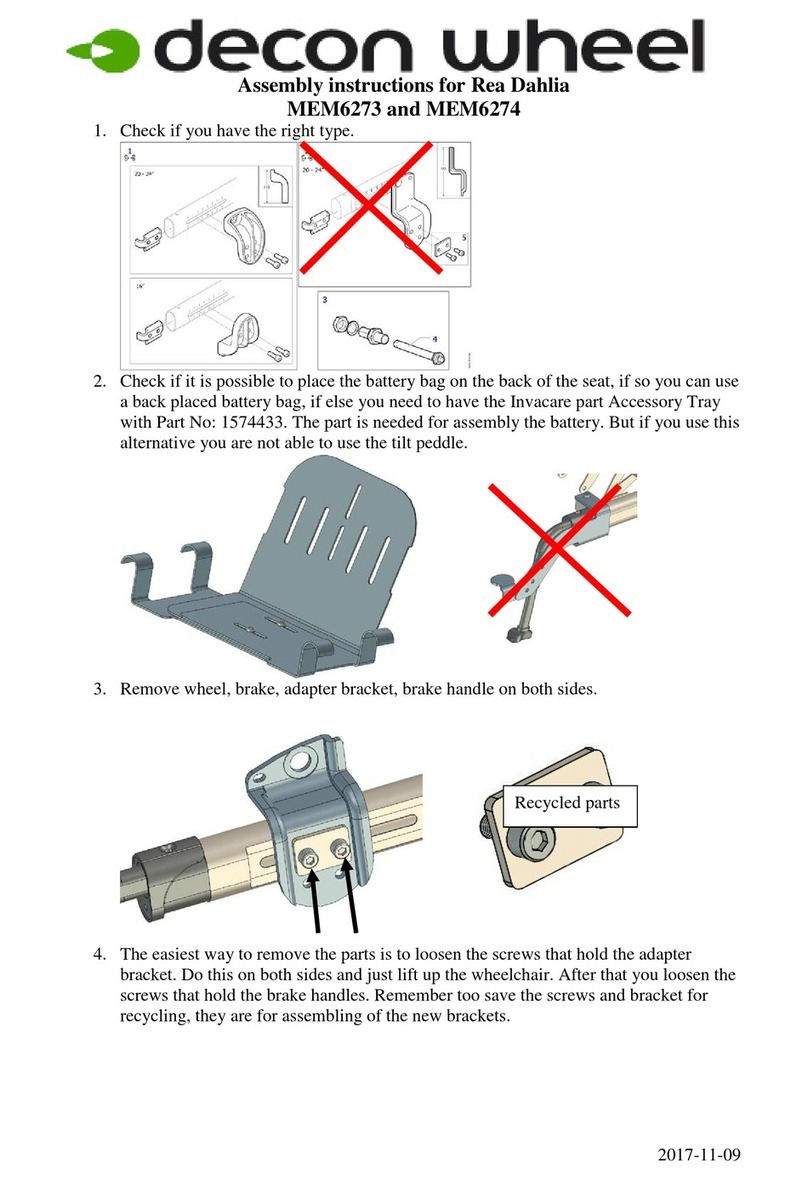decon E-Move MEM20 User manual

E-Move
User manual
2020-09
Original manual

EC Declaration of Conformity
The undersigned, representing the following manufacturer:
Decon Wheel AB
Org.no. 556618-9006
Södra Ekeryd 119, 314 93 HYLTEBRUK
SWEDEN
hereby declares that the product
E-Move part No. series:
MEM20 MEML20
MEM22 MEML22
MEM24 MEML24
MEM25 MEML25
MEM26 MEML26
is in conformity with the provision of the following EC directive, including all applicable amendments:
93/42 EEC Medical Device Directive –Class 1 –annex VII.
The manufacturer is exclusively responsible for this EC Declaration of Conformity.
This declaration is valid until June 30, 2021
Benny Andersson
COO

Important information
Responsibility
Decon cannot be held responsible for product changes made by unauthorized people. As a part of an on-
going product improvement initiative, Decon reserves the right to change specications and design with-
out notice.
Label location
CE Marks are placed on the motor, on the label on the battery, and on the label on the battery charger,
which even is marked with the registration number including production year and month.
CE Mark
CE Mark
CE Mark
Production
year-month
Registration
number

Table of Contents
1. Please read before use 1
1.1. Foreword 1
1.2. Symbols Used in This Manual 1
1.3. Operation Diagnosis Check 2
1.4. Assistive Operation Diagnosis Check 3
1.5. Warnings and Notes for the Operation 4
1.6. Warning Label Location Diagram 19
2. Names of Parts 21
2.1. E-Move 21
2.2. Nickel Metal Hydride Battery (JWB2) 22
2.3. Lithium Ion Battery (ESB1) 23
2.4. Charger for Lithium Ion and Nickel Metal Hydride Battery (ESC3) 24
3. Before Sitting in the Wheelchair 25
3.1. Inspecting the Wheelchair 25
3.2. Checking Your Clothing 29
3.3. Checking the Residual Capacity of the Battery and
Installing the Battery on the Wheelchair 29
4. Riding the Wheelchair 32
4.1. Sitting in the Wheelchair 32
4.2. Moving the Wheelchair 33
4.3. Checking the Residual Capacity of the Battery
during Operation 34
4.4. Other Functions 34
4.5. Practicing Basic Operations 35

5. After You are Finished Riding the Wheelchair 38
5.1. Getting out of the Wheelchair 38
5.2. Removing the Battery 39
6. Handling the Batteries and Chargers 41
6.1. Types of Batteries 41
6.2. Maintenance 41
6.3. Warnings and Notes for Battery Handling 42
7. Nickel Metal Hydride Battery and Charger 46
7.1. Features of the Nickel Metal Hydride Battery (JWB2) 46
7.2. How to Use the Nickel Metal Hydride Battery (JWB2) 46
7.3. Characteristics and Handling of the Nickel Metal
Hydride Battery (JWB2) 48
7.4. How to Charge the Nickel Metal Hydride Battery (JWB2) 50
7.5. Refresh Charging the Nickel Metal Hydride Battery (JWB2) 54
7.6. Charger (ESC3) Indicator Lamps 56
8. Lithium Ion Battery and Charger 58
8.1. Features of the Lithium Ion Battery (ESB1) 58
8.2. How to Use the Lithium Ion Battery (ESB1) 58
8.3. Characteristics and Handling of the Lithium Ion Battery (ESB1) 60
8.4. How to Charge the Lithium Ion Battery (ESB1) 63
8.5. The Temperature of the Lithium Ion Battery (ESB1) during Charging 67
8.6. Charger (ESC3) Indicator Lamps 68
9. Wheelchair Transporting and Storing Instructions 69
9.1. Loading the Wheelchair in a Car 69
9.2. Unloading the Wheelchair from a Car 71

9.3. Storing the Wheelchair 72
9.4. Long-term Storage of the Wheelchair
(more than 3 months) 73
9.5. Boarding an Airplane 73
10. Wheelchair Disassembly and Adjustments 74
10.1. Removing and Installing the Unit 74
10.2. How to Remove Battery Bag of E-Move (Battery Separated Type) 77
10.3. Anti-tip device 80
10.4. Smart Tune Settings 83
11. Maintenance, Daily Check, Periodic Inspection 84
11.1. Maintenance 85
11.2. Daily Checks 86
11.3. End of E-Move Use Recycling 86
12. DimensionsandSpecications 87
12.1. Dimensions 87
12.2.Specications 88
13. Troubleshooting, Repairs, Warranty 90
13.1. Before Requesting Repairs 90
13.2. Requesting Repairs and Inspections 93
13.3. Serial Number Location 93
13.4. Warranty 93
13.5. Safety Notice and Product Recall 94

Introduction
This is a manual for the E-Move electric power assist unit for wheelchairs. Before you read this manual,
check which product you are using. For information on the wheelchair frame to which E-Move is attached,
see the owner’s manual from the frame manufacturer.
This product consists of the left and right drive units, battery and the battery charger. The drive units are
already installed to the wheelchair frame. For the initial use, the customer does not have to use tools,
and so on, to assemble the wheelchair. Refer to “2. Names of Parts” to ensure that these components
are installed to the wheelchair that you purchased and that the battery and charger are included. If you
visually notice that any of these components are not installed, are not included, or are damaged before
using the wheelchair, immediately contact the dealer without using the wheelchair.
E-Move
For information for operating the wheelchair frame and warranty for the frame with which you are using
the E-Move, see the frame manual.
This user manual printed in large letters is available for visually impaired persons. Ask your dealership.
WARNING
● ReadandunderstandthismanualcompletelybeforeoperatingyourE-Moveproduct.This
manual should be considered a permanent part of your product and should remain with it.

1
1
1. Please read before use
Caution: Federal law restricts this device to sale by or on the order of a practitioner licensed by the law of
the State in which he/she practices.
1.1. Foreword
Thank you for purchasing the E-Move.
Indication for use: The device E-Move is a Powered Wheelchair Conversion Kit and suitable for a disabled
person who can’t walk or has restrictions on walking. It is intended for medical purposes to provide a means
for a disabled person to take over the propulsion of the wheelchair and increase mobility and exibility.
The device is intended for indoor and outdoor use.
Generally speaking, riding in a wheelchair incurs the possible risk of personal injury or damage to the
wheelchair from improper use. Depending on the type or extent of the disabilities of the user, it might be
dangerous to travel unaccompanied.
Before using the wheelchair, be sure that not only the user, but also the assistant and controller, has read
this manual to assure full understanding.
(1) The wheelchairs on which the E-Move has been installed are wheelchairs for physically handicapped
people, and legal status of someone in a wheelchair is that of a pedestrian. Make sure to adhere to
the trac rules and manners of a pedestrian.
(2) The E-Move withstands a load of 130 kg (286 lb). Use with a total maximum load included the chair
frame weight of 130 kg (286 lb). If the frame on which the E-Move is installed has an even lighter
load capacity, ensure that you do not exceed that value.
(3) To help ensure safe use, warning labels are axed to this product. Make sure to adhere to the warning
labels. Refer to “1.6. Warning Label Location Diagram” for the locations of the warning labels.
(4) Do not use this product for any purpose other than as an electric wheelchair.
(5) Some of the illustrations in this manual are images of general electric wheelchairs. The actual
product may be dierent than that shown.
1.2. Symbols Used in This Manual
This is the safety alert symbol. It is used to alert you to potential
personal injury hazards. Obey all safety messages that follow
this symbol to avoid possible injury or death.
A WARNING indicates a hazardous situation which, if not avoid-
ed, could result in death or serious injury.
WARNING
A NOTICE indicates special precautions that must be taken to
avoid damage to the product or other property.
NOTICE
Indicates things you must not do.
A TIP provides key information to make procedures easier or
clearer.
TIP

1
2
Can operate
both.
Have trouble operating
one or both.
Power assist use is dangerous.
Do not use E-Move.
You can travel unaccompanied. For your safety, remember to travel carefully.
In situations such as those mentioned in the warnings in “1.5. Warnings and Notes for the Operation”,
be sure to have an assistant accompany you, and pay sucient attention to safety while traveling.
1.3. Operation Diagnosis Check
Depending on the extent of your disabilities, it may be dangerous to travel unaccompanied. Use this diag-
nosis check as a guide to determine whether or not you can travel unaccompanied.
(1) Are you able to travel using the handrims?
(2) Are you able to correctly perceive visually the conditions of the road surface and your
surroundings, and avoid dangerous areas?
Diagnosis Check
Can operate
both.
Have trouble operating
one or both.
Have an assistant
accompany you.
(1) Are you able to operate the switches and parking brakes?
(2) Are you able to get in and out of the wheelchair, and to replace the battery?
Diagnosis Check
WARNING
● Beforeusingthewheelchair,besuretoassessyourcompetenceanddeterminewhetheror
not you need an assistant.
Moreover, in determining the necessity of an assistant, consult expert opinions as a point of
reference.
If your judgment is based solely on your own opinion, you or other people around you may
get injured.

1
3
1.4. Assistive Operation Diagnosis Check
Use the diagnosis check below as a guide to determine whether or not you can provide assistive
operation.
If you feel uncomfortable with any of the 3 tasks below, do not provide assistive operation.
(1) Are you able to correctly perceive the conditions of the road surface and your surroundings,
and avoid dangerous areas?
(2) Are you able to assist the user to get on and o the wheelchair, and to replace the battery?
(3) Are you able to provide assistive operation on a manual wheelchair?
Diagnosis Check
WARNING
● Ifanassistantistoaccompanyyouandoperatethewheelchair,besuretoassesshisorher
competence.
Moreover, when assessing the assistant’s competence, consult expert opinions as a point
of reference.
If your judgment is based solely on your own opinion, you or other people around you may
get injured.
● Ifyoulackthecompetencetoprovideassistiveoperation,donotattempttoprovideit.

1
4
1.5. Warnings and Notes for the Operation
Read this manual before using the product.
Read this manual carefully to ensure safe and comfortable operation. After reading it, store it where it can
be accessed easily for future reference.
Unless specically noted, the following information applies to when the user is operating the wheelchair
themselves and when an assistant is operating the wheelchair using the assistant operations.
1.5.1. Before Using the Wheelchair after Purchasing the Unit
WARNING
● Beforeusingthewheelchair,besuretoassessyourcompetenceanddeterminewhetheror
not you need an assistant.
Moreover, in determining the necessity of an assistant, consult expert opinions as a point
of reference.
If your judgment is based solely on your own opinion, you or other people around you may
get injured.
● Practicetravelingonalevelandsafeareawithanassistantaccompanyingyou,untilyou
are comfortable with the operation. If you go on public roads while still unfamiliar with the
operation, you or other people around you may get injured.
1.5.2. Before Use Each Day
WARNING
● Performthedailychecksbeforeuseeachday.Makeahabitoutofinspectingthe
wheelchair. Continued use of the wheelchair with a problem in the wheelchair body or the
wheels may cause damage to the wheelchair while traveling, and may result in a rollover or
fall.
● Beforeusingthewheelchaireachday,ensurethat
there is air in the tires. Always keep the air pres-
sure in the rear tires at a normal level. If the air
pressure in the rear tires decreases, the parking
brakes may become ineffective.

1
5
WARNING
● Beforeusingthewheelchaireachday,ensurethat
the anti-tip devices are in the correct position. If
the anti-tip devices are not in the correct position,
the wheelchair could fall backward.
● Beforeusingthewheelchaireachday,checkthe
residual capacity of the battery. If the residual
capacity of the battery is low, the battery may
run out during operation and it may become
impossible to travel in power drive mode.

1
6
1.5.3. Handling the Wheelchair
WARNING
● Ifthewheelchairhaspartsthatarefoldableordetachable,donotoperatethewheelchair
with those parts folded or removed.
● Whenliftingthewheelchair,donotholdmovableparts.
● Donotoperatewithanyheavybaggagehanging
over the backrest, or with any heavy objects in
the compartment. The wheelchair could easily fall
backward on an inclined slope, and may cause
you or other people around you to get injured.
● Thewheelchairmaytipoverifitisoperatedwiththeanti-tipbarremoved,folded,orwith
the safety wheels facing upwards. Be sure to set the anti-tip bar correctly and operate the
wheelchair with the safety wheels in the correct position.
● Modifyingtheunitoritsmountingmayadverselyaectitsperformanceandsafety.
Nevermakeanymodications.
● Donotconnectanyelectricinstrumentstothebatteryseatplug.ThisplugistoconnectPC
for the Smart Tune software. Plugging other electric instruments like audio microphone or
earphones may cause unit trouble.
About the Smart Tune software, refer to section 10.
● Removingthebatterywhiletravelingcausesthe
brakes to be applied to the rear tires, and may
cause you or other people around you to get in-
jured.
● Whilethewheelchairisbeingoperatedorafterop-
eration, do not touch the back of the drive units.
During or after operation, the back of the drive
units may be hot. In addition, if the wheelchair is
near a source of heat, the drive units may become
hot.
Back of the unit
(Both side)
Back of the unit
(Both side)

1
7
WARNING
● Whileoperatingthewheelchair,becarefulnotto
get your hands tangled in the wheel spokes, wheel
holes, etc.
WARNING
● Whengettinginthewheelchairbyyourselfor
when the assistant has the user of the wheelchair
get in the wheelchair, ensure that the wheelchair
is on a level ground. If the user attempts to get in
the wheelchair on an incline, he or she may lose
balanceandfallothewheelchair.
● Toswitchtheclutchleverstothemanualposition,suchaswhenstartingassistant
operations, apply the parking brakes on a level and stable ground, and then with the power
turnedo,switchtheclutchlevers.
● Ifyouareusingawheelchairwithnoparkingbrakes,havetheassistantholdthewheelchair
to ensure that it does not move. Failure to observe the above may cause the wheelchair to
start moving unexpectedly, and may result in you or other people around you to get injured.
● Donotleanoutofthewheelchairtoretrieveanitem.Otherwise,youcouldfalloffthe
wheelchair or the wheelchair could tip over.
1.5.4. Getting In/Out of the Wheelchair, Seating

1
8
1.5.5. General Operation
● Neverridethewheelchairwithtwopeople.
The wheelchair may malfunction or the people rid-
ing it may get injured.
WARNING
● Nevertowthewheelchair.Donotusethewheelchairtotoworpullanything.
● Neveroperatethewheelchairwhileholdinganumbrellaorotheritems.
● Ifyouwanttouseaportablephone,etc.,stop
the wheelchair at a safe place and turn off the
wheelchair. Moreover, while traveling in power
drive, keep portable telephones and other
electronicdevicesturnedo.Otherwise,thereisa
risk of an accident.
● Donotoperatethewheelchairnearadevicethatproducesstrongradiowaves.Ifthe
wheelchair is near a source of radio waves and starts to operate abnormally, immediately
turnothepower,andquicklymoveawayfromthatlocationusingtheassistantoperations
or manual operation.
The weak electromagnetic waves emitted by the E-Move may affect other electronic
devices,suchasautomaticdoorsandtheanti-theftsystemsofstores.Inthiscase,turno
the power and operate the wheelchair using the assistant operations or manual operation.
● Neveroperatethewheelchairafterconsumingalcoholortakingmedicinethatcauses
drowsiness.

1
9
WARNING
● Donotridewithclothingthatisunsafeforwheelchairs,suchasshownbelow.Ifyoudrive
with such clothing, you or other people around you may get injured.
● Donotusethewheelchairfortransporting
luggage or for any other purpose than to provide
assistance to a disabled person.
Long scarves Clothing with loose sleeves
Pants/skirts with wide hems Bare feet, sandals, slippers,
ill-tting footwear, etc.
● Donotturnthepowerswitchowhiletraveling.
It causes the brakes to be applied to the rear
wheels in some cases and may cause you to fall
down from the wheelchair.
Power
switch
o

1
10
In the following environments and situations, you may need an assistant to accompany you and to operate
the wheelchair for you.
In such cases, have an assistant accompany you. Traveling alone in these situations may lead to injury.
Moreover, check to see if any dangers such as those shown below exist in the roads you use on a daily
basis. If so, select a route that does not pass through such areas.
Always check the surrounding conditions to ensure safety.
1.5.6. Operation on Public Roads
WARNING
● Althoughthewheelchaircanbeoperatedonpedestrian-onlyroads,itcannotbeoperated
where pedestrians are not allowed (car roads, in the middle of a road, etc.).
● Whenthewheelchairisoperatedoutdoors,itslegalstatusisthatofapedestrian.Make
sure to adhere to the rules and manners of a pedestrian.
● Ongeneralroads,becarefulofautomobiles,bicycles,andpedestrians. Inparticular,pay
the utmost attention to pedestrians.
● Iftheroadhasasidewalk,operatethewheelchaironthesidewalk.
● Iftheroaddoesnothaveasidewalk,operatethewheelchaironthesidestripoftheroad
where pedestrians walk.
● Iftheroaddoesnothaveasidestrip,operatethewheelchaironthesideoftheroadwhere
pedestrians walk.
● Iftwoormorewheelchairsaretravelingtogetheroutdoors,thewheelchairsshouldbe
operatedinasinglelinewithsucientspacebetweenthewheelchairs.Thewheelchairs
should not be operated side by side.
● Whenstartingofformovingbackward,becarefulofotherpeopleandobstaclesaround
you.
● Itisextremelydangeroustotravelonanarrowstreetwithoutasidewalk.Chooseasafer
path whenever possible.
● Becarefulnottotraveltooclosetotheedge
when traveling on an embankment, etc., of a road.
Depending on the condition of the shoulder of the
road,youcouldaccidentallymoveotheroad.
● Whentravelingonasidewalkthatdoesnothaveaguardrail,thereisariskoffallinginto
the street side. Have an assistant accompany you instead of traveling alone.

1
11
WARNING
● Ifthereareanyobstacles,stopthewheelchairandcheckinfrontofyouandbehindyoufor
safety before proceeding.
● Whentravelingnearaditch,thetiremayfallintoitifthereisagapevenifitiscovered.
Have an assistant accompany you instead of traveling alone.
● Ifanoncomingvehicleisnear,stopthewheelchair,waitforthevehicletopass,andthen
check in front of you and behind you for safety before proceeding.
● Donotoperatethewheelchairoutdoorsatnight.
Not being able to see the road conditions, you
may lose balance and fall, or people or cars may
collide into you if they cannot recognize you.
● Ifitisrainingorsnowing,donotoperatethewheelchairoutdoors.Automobilesandother
vehicles may collide into you if they cannot recognize you. If it starts to rain or snow while
you are outdoors, move indoors as soon as possible.
WARNING
● Donotusethewheelchaironaslopesteeperthan
6 degree (10% grade). It may tip over or the brake
maybecomeineective.
● Whengoingup/downaparticularslopeforthersttime,haveanassistantaccompanyyou
to ensure safety.
1.5.7. Operation on Slopes
The wheelchairs equipped with the E-Move are built to be lighter compared to other heavier
electric wheelchairs that use a general lead battery. For this reason, when a person sits in it,
the overall center of gravity shifts higher. Therefore, caution is necessary when traveling on a
slope.
Over 6°

1
12
WARNING
● Donotoperatethepowerswitchonaslope.
The wheelchair behaves as a normal wheelchair
whileswitchedo.Itmaystarttomove.
Park on a level place and apply the parking brake
when you operate the power switch.
● Donotabruptlyturnonadownhillslope.In
addition, do not traverse horizontally or diagonally
across a steep slope. You could easily lose
balance and tip over.
● Onadownhillslope,startthebrakingoperation
early. The braking distance on a downhill slope
may be significantly longer than when traveling
on level ground.
● Intheareaswherethewheelchairleanssharply
to the left or right, the wheelchair may tip over
sideway. Have an assistant accompany you.
● Whendescendingdownaslopewiththeassistant
operations, descend in reverse. If the assistant
moves the wheelchair forward when descending,
thepassengermayplungeforwardandfallothe
wheelchair.

1
13
1.5.8. Going Up/Down Curbs
The wheelchairs equipped with the E-Move are built to be lighter compared to other electric
wheelchairs that use a heavier general lead battery. For this reason, when a person sits in it,
the overall center of gravity may be different. Therefore, use caution when traveling on a curb.
● Whengoingup/downacurbforthefirsttime,haveanassistantaccompanyyouinsteadof
traveling alone.
● Whentravelinginpowerdrivemode,thewheelchaircanclearleveldifferencesofapprox-
imately 25 mm (1 inch) (varies depending on the caster size). Any greater level differences
should be cleared by an assistant by manual push operation.
WARNING
● Becausethefrontcastersaresmall,theyareabletotraveloveronlysmallcurbs.There-
fore, caution is necessary when traveling over curbs in power drive mode.
● Whentravelingoveracurb,becarefulnottoloseyourbalance.
● Whentravelingoveracurb,proceedatarightangletothecurb.Donottraversethecurb
diagonally.
● Whentravelingbetweenasidewalkandaroad,becarefulofcurbs.
● Whendescendingfromacurbwiththeassistantoperations,descendinreverse.Ifthe
assistant moves the wheelchair forward when descending, the passenger may plunge
forwardandfallothewheelchair.
● Whengoingup/downacurbwiththeassistantoperations,thesafetywheelsoftheanti-tip
bar may be raised or folded temporarily depending on the height of the curb. After traveling
over the curb, be sure to place the safety wheels of the anti-tip bar in the correct position
before operating the wheelchair.
This manual suits for next models
9
Table of contents
Other decon Wheelchair manuals
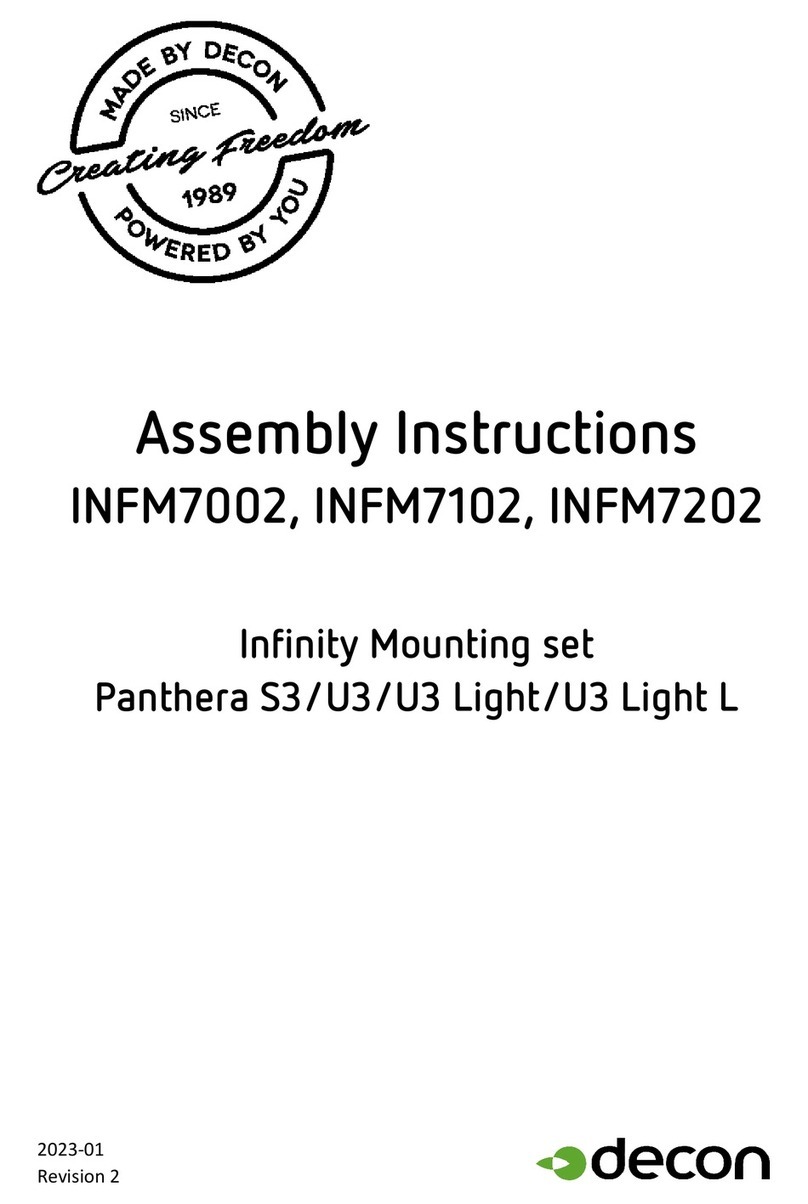
decon
decon INFM7002 User manual
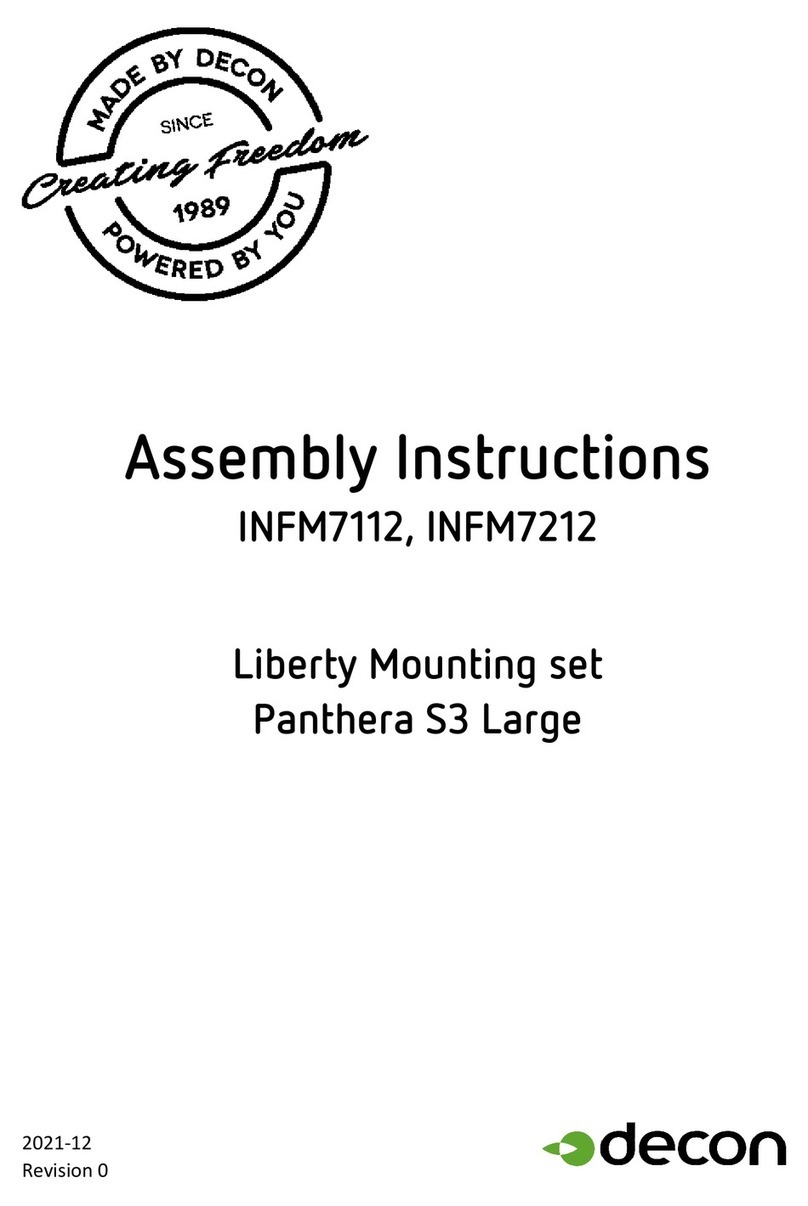
decon
decon Panthera S3 Large User manual
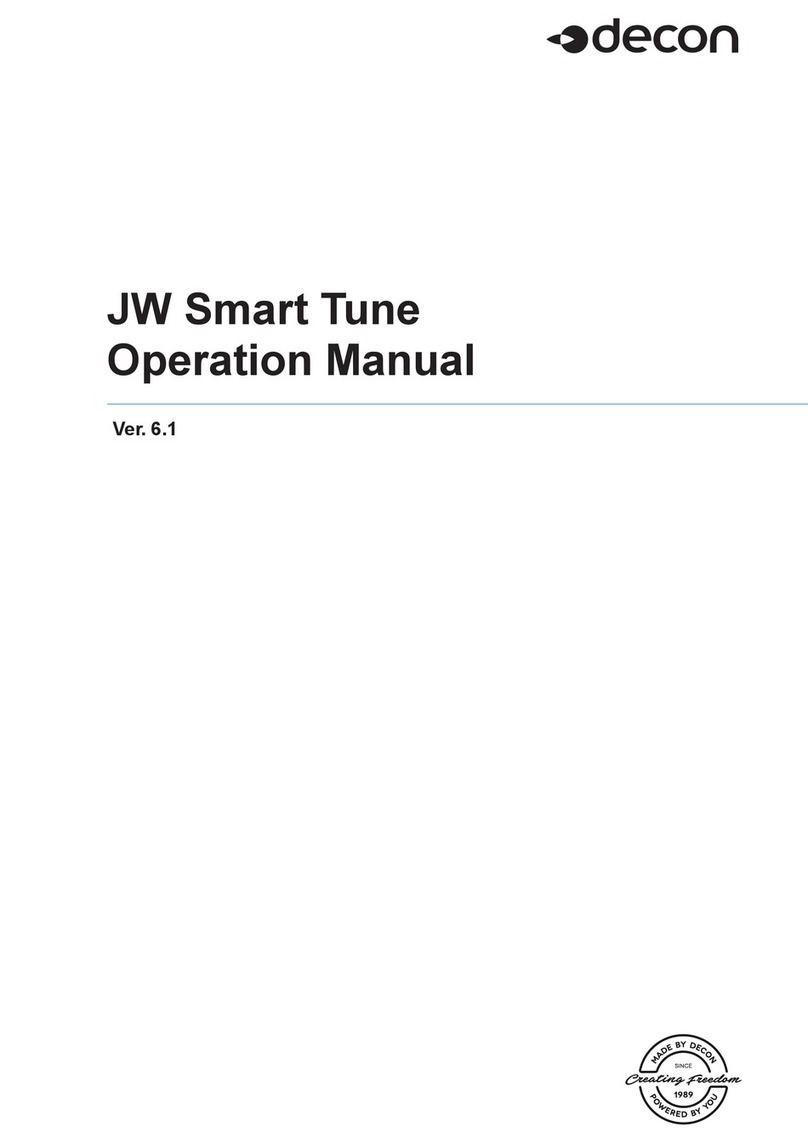
decon
decon JW Smart Tune User manual
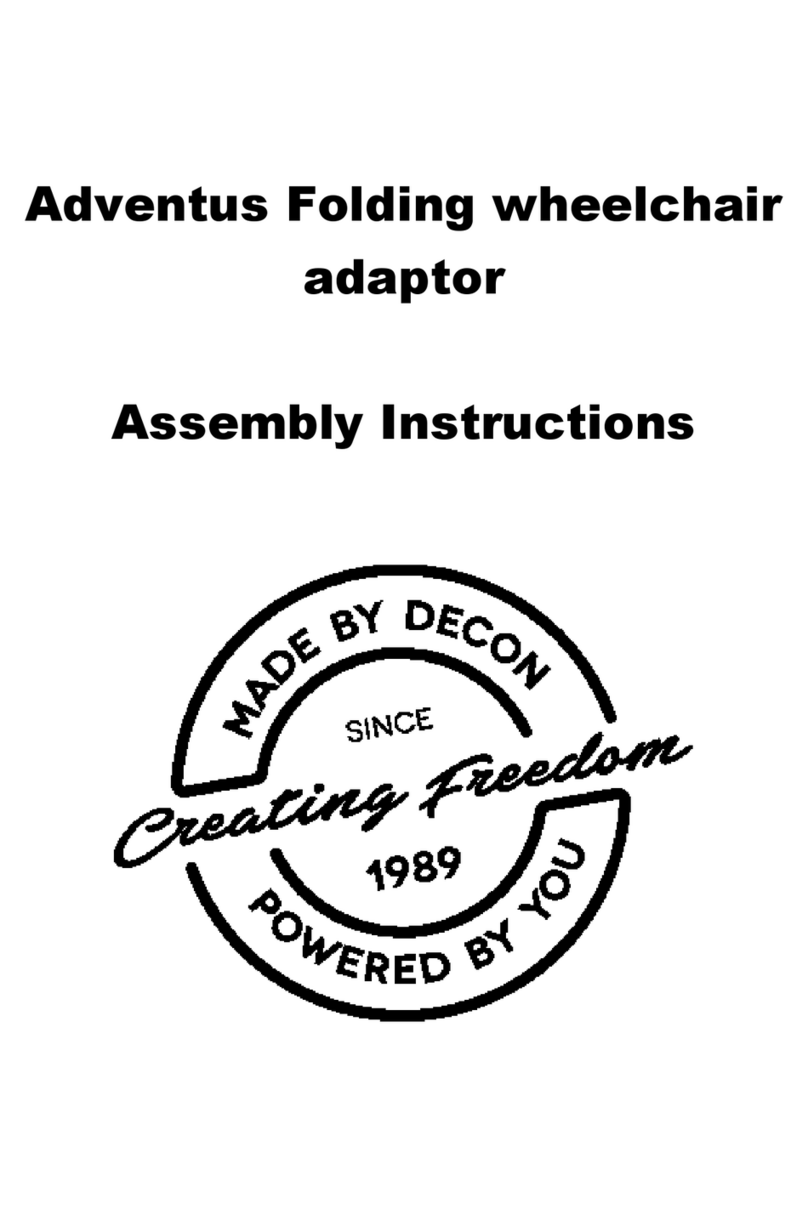
decon
decon Adventus Quick start guide
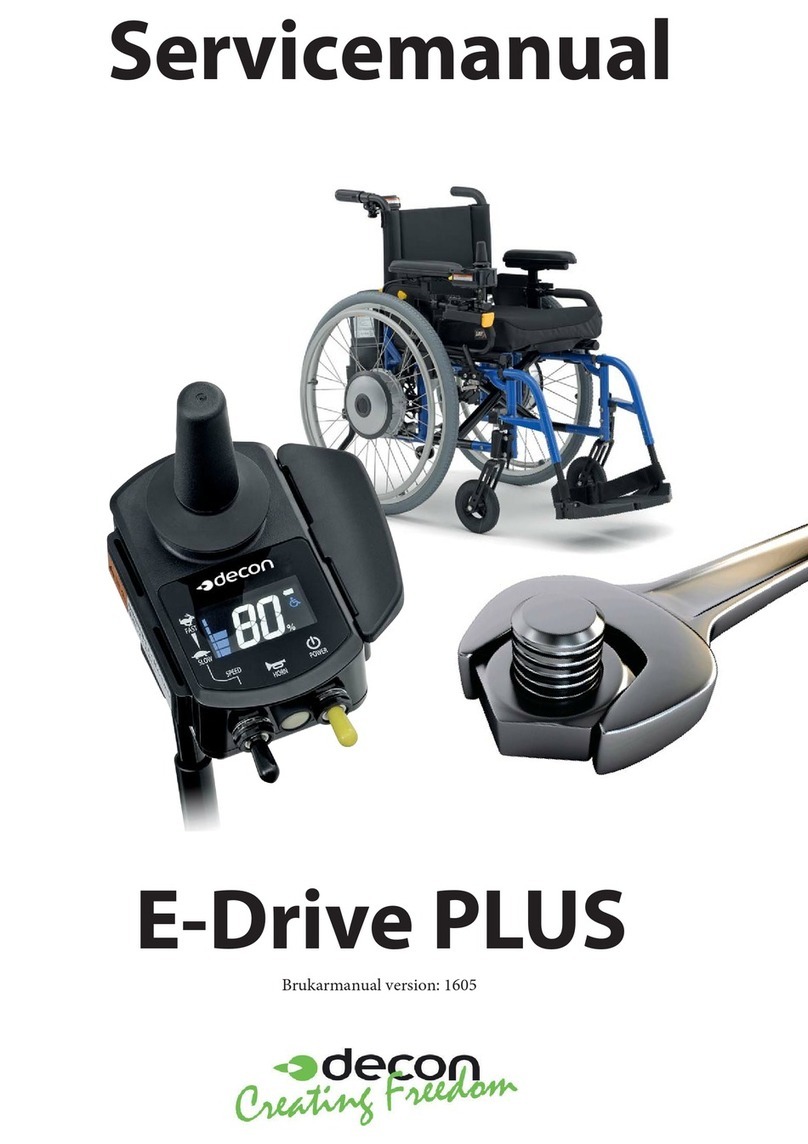
decon
decon E-Drive PLUS User manual
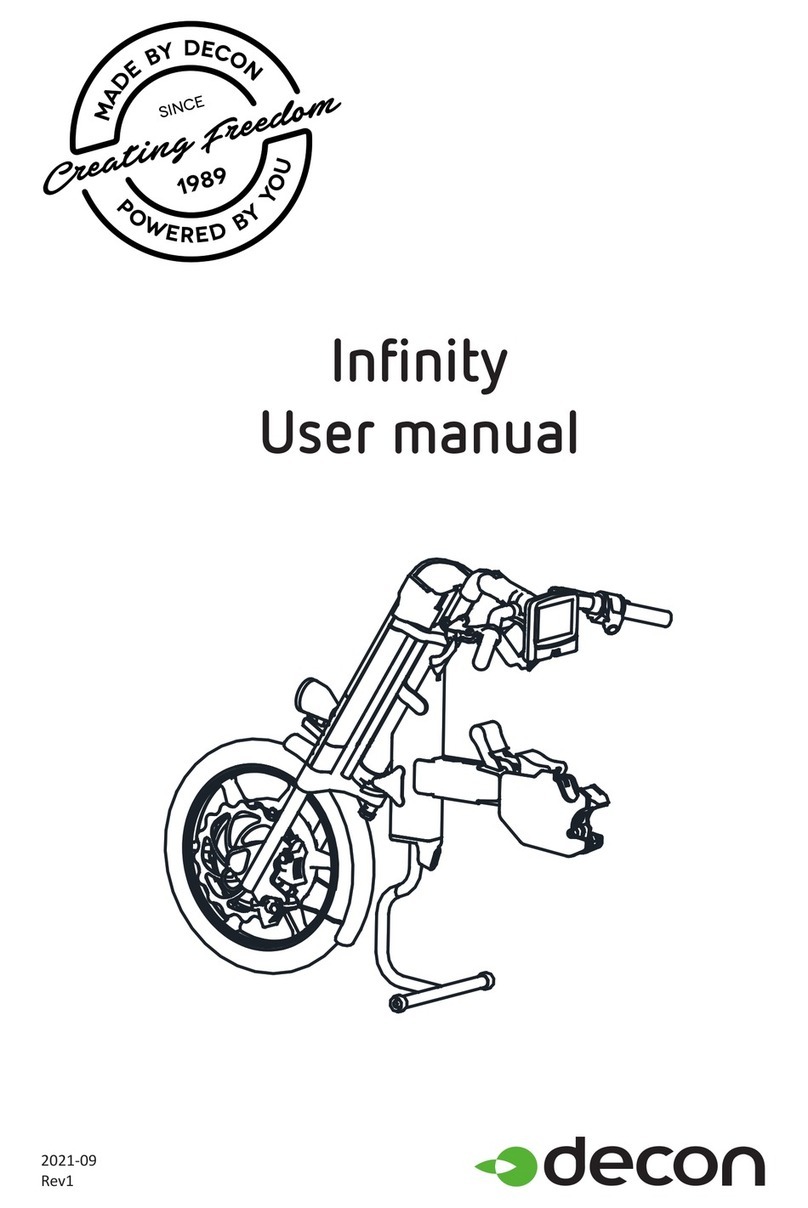
decon
decon Infinity User manual

decon
decon Gearwheel User manual

decon
decon Liberty LBM7013 User manual
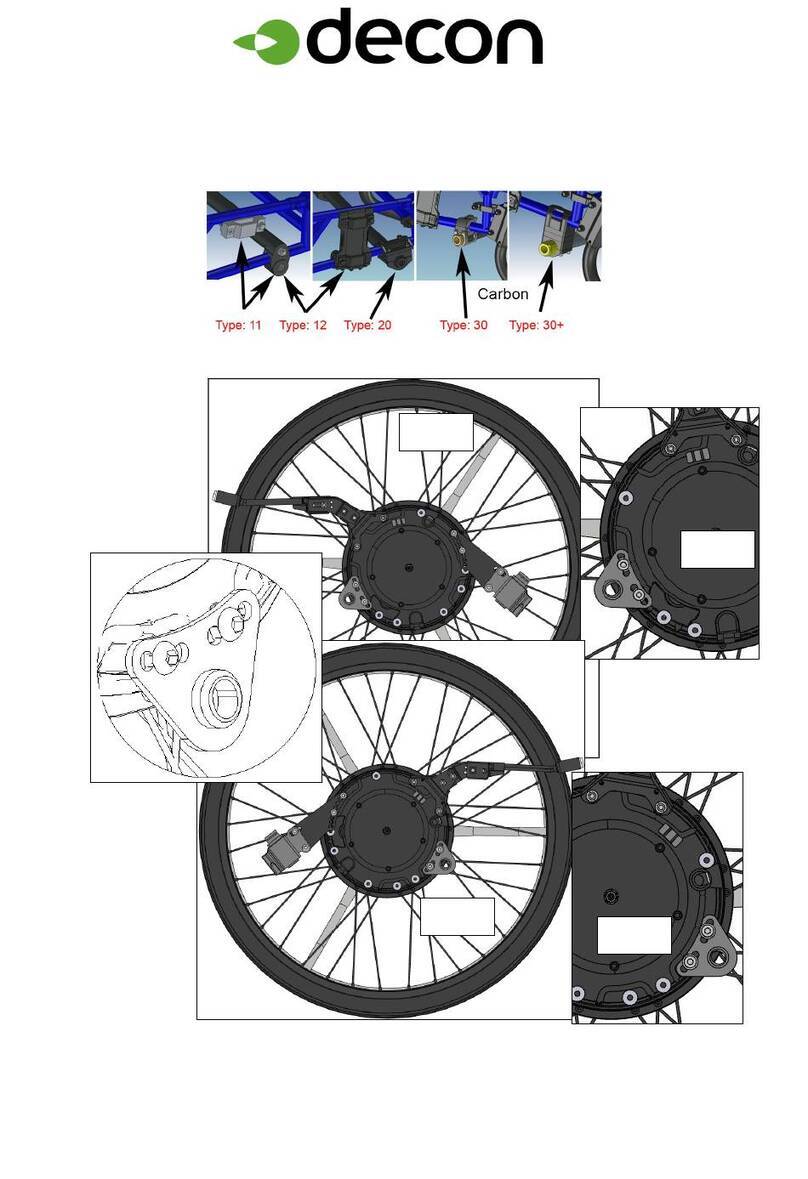
decon
decon Panthera S2/U2 User manual
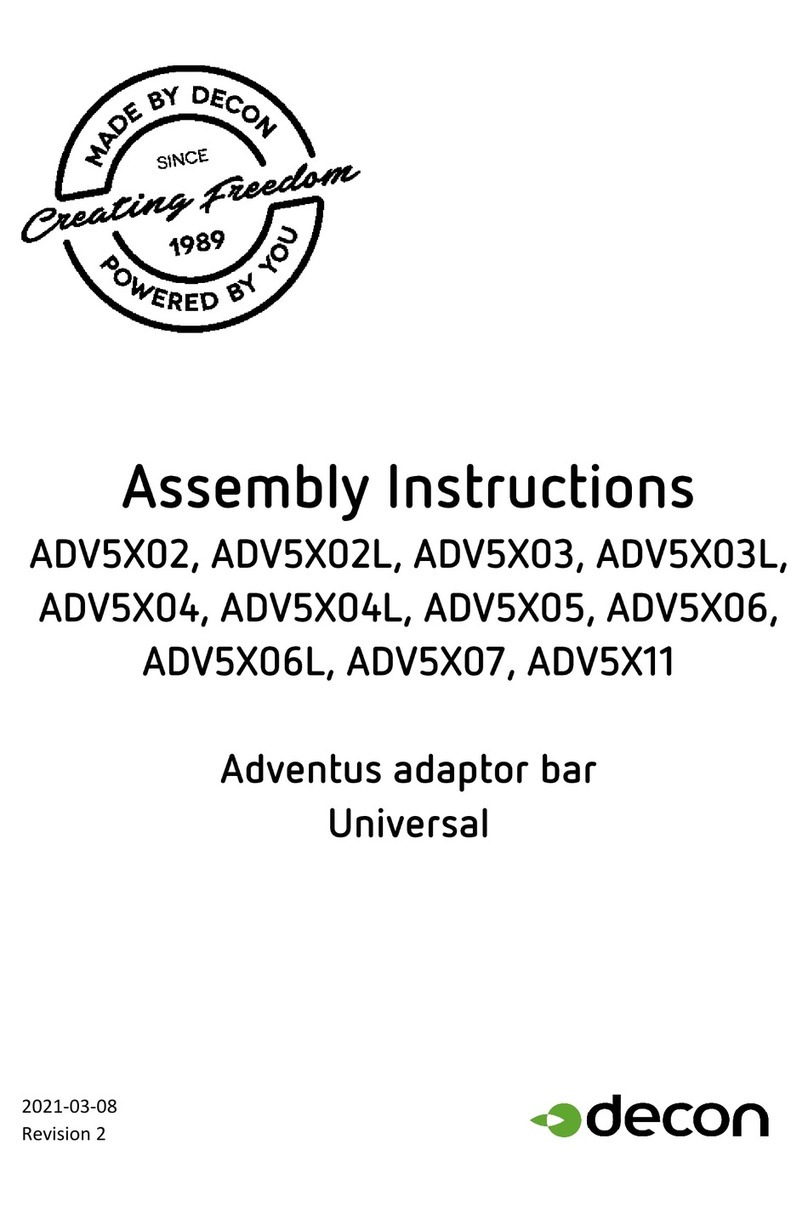
decon
decon ADV5X02 User manual
